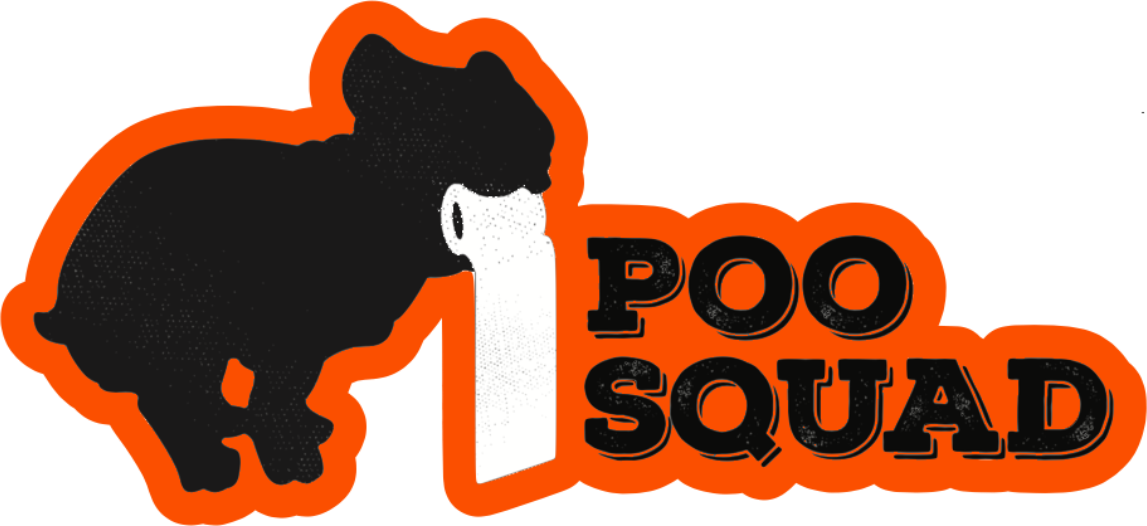What to Do With Dog Poop | Disposal Methods
Dog poop should never be left in the yard or flushed without checking local rules. Bag and trash it using sealed bins, install a digester, compost for non-edible use, or hire a pet waste removal service for hands-free cleanup. Hygiene and local compliance matter.
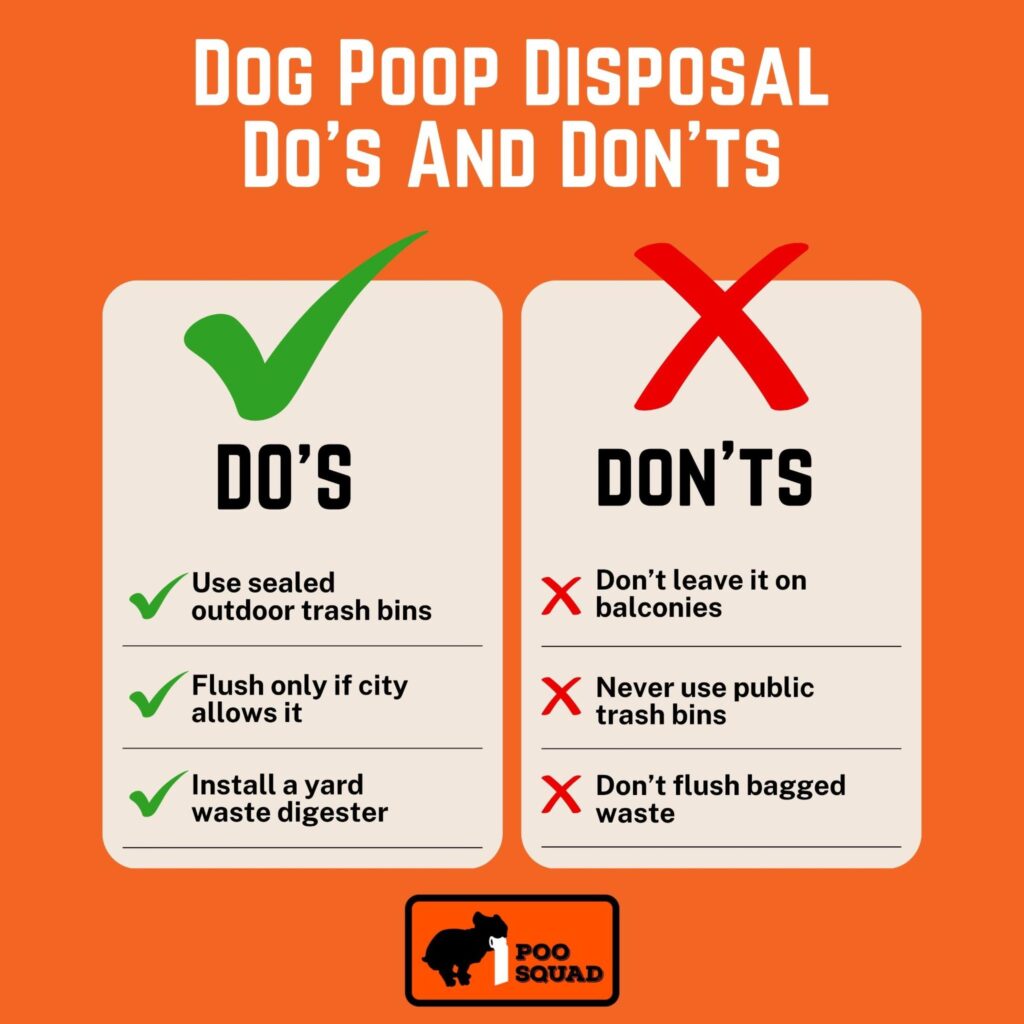
If you’re bagging and trashing, you might be doing it wrong (especially if it’s in your garage). If you’re composting, the method matters. And if you’re hoping to never touch it again, there’s a clean, professional way to make that happen.
This guide breaks down all your options: trash, flush, compost, digesters, or professional pickup, and weighs each against hygiene, effort, and environmental impact.
Whether you live in a high-rise apartment or a home with acreage, we’ll help you find the right dog waste solution for your lifestyle.
And if you’re already part of a pet waste service like Poo Squad, we’ll show you how features like Dog Poop Report Cards and secure gate check-ins make this the easiest, and cleanest, way to never think about poop again.
Why Dog Poop Disposal Matters
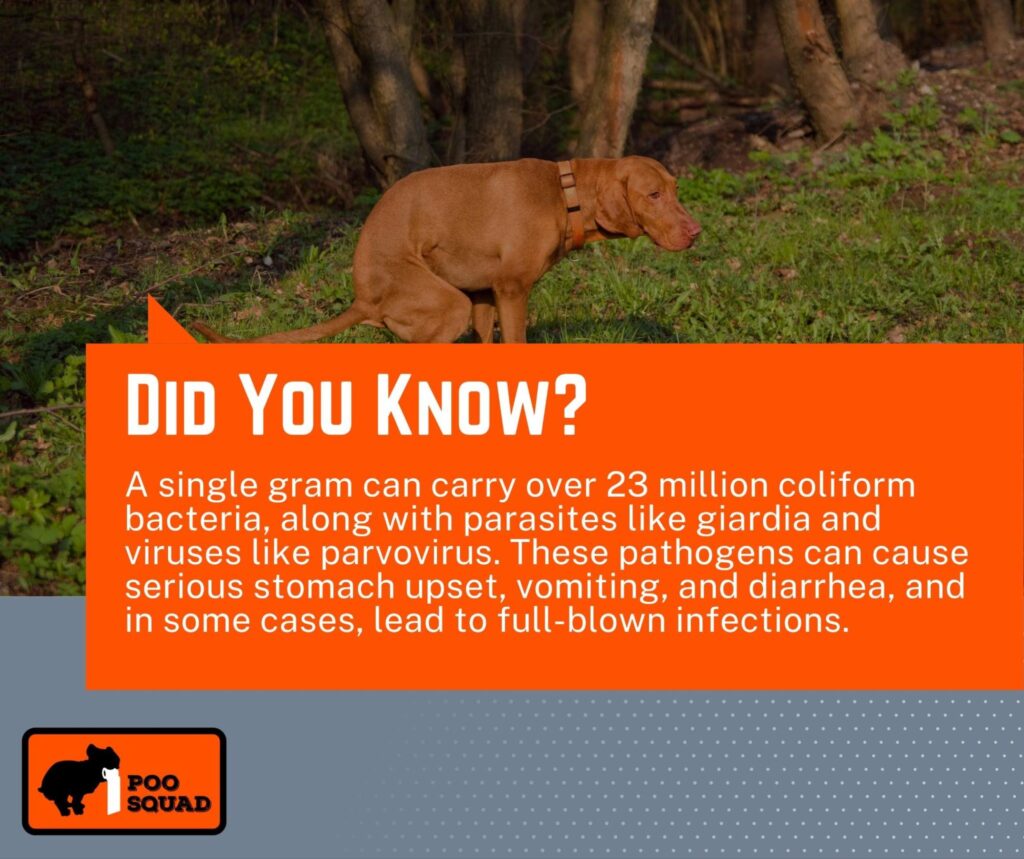
There’s a reason it’s not just “out of sight, out of mind.” Dog poop doesn’t just look gross, it carries harmful bacteria like E. coli, parasites, and over 23 million coliform organisms in a single gram. That’s not something you want lingering where your kids play or your dog rolls around.
A common myth says it’s good for grass.
It’s not. Dog waste is acidic, not nutrient-rich like cow manure, and letting it pile up can burn your lawn bare. If your yard’s turning patchy or yellow, that’s likely your culprit.
But the damage doesn’t stop in the backyard. Rain can carry waste into drains, sending bacteria straight to local waterways. It’s one of the sneakiest contributors to stormwater pollution and algae blooms that choke out fish and wildlife.
If someone else is picking it up for you, chances are you never even see what’s coming out the back end. That’s why our techs send a quick Dog Poop Report after every visit if something looks off. Diarrhea, discoloration, strange contents, we’ve seen it all, and catching it early can make all the difference.
Common Methods to Dispose of Dog Poop (Pros and Cons)
No one method works for everyone. Your home setup, climate, and tolerance for… well, mess, will guide which option makes the most sense. Here’s what works, what doesn’t, and where things can get nasty if you’re not careful.
Trash It (the Right Way)
Bag it and toss it. But there’s a right way and a wrong way.
Yes, biodegradable bags exist, but most landfills aren’t designed to break them down properly. In most cities, they’ll sit just like plastic.
The better move?
Use strong bags that won’t leak and store them in a sealed outdoor bin until trash day.
Indoor trash can?
Only if you enjoy eau de dog. The smell builds fast, especially in warmer months. One of the biggest benefits of using a pickup service is never having to stash a week’s worth of poop in the garage. That’s why professional teams never use your bins. It’s your home, not a dump site.
As for tossing a bag into the nearest neighbor’s can?
That’s a fast track to some very awkward sidewalk conversations. Technically, it’s often illegal and frowned upon.
Flush It (If Your City Allows)
Yes, flushing dog poop is legal in some places, check your local guidelines. The appeal is clear: no bags, no bins, and out of your house for good. But it comes with caveats.
Most flushable bags don’t live up to the name. They clog pipes and confuse plumbing systems that weren’t built for pet waste. And while enzyme treatments sound promising, they require careful use and frequent maintenance. One slip and you’ve got more problems than a full yard.
Compost It (Not for Gardens)
You can compost dog poop, but only if you do it right. That means a dedicated bin, a steady mix of sawdust or carbon materials, and temperatures high enough to kill pathogens. It also means never using the compost on anything you plan to eat. This stuff’s for flowers and shrubs only.
Thinking of digging a hole in the backyard and calling it compost?
Without a real system in place, that’s more like burying bacteria. The only safe way to go underground is with a proper digester, which leads us to…
Install a Dog Waste Digester
This one’s a favorite for hands-off homeowners who still want a DIY option. These mini septic tanks sit in your yard and use enzyme packets plus water to safely break down dog waste over time.
They’re relatively low-cost and easy to install, but they do take some upkeep. If the enzyme-to-waste ratio gets off or you forget to add water, things get… unpleasant. Regular maintenance avoids the smell, but neglect one and you’ll know fast.
Pet Waste Removal Services: The Hassle-Free Option
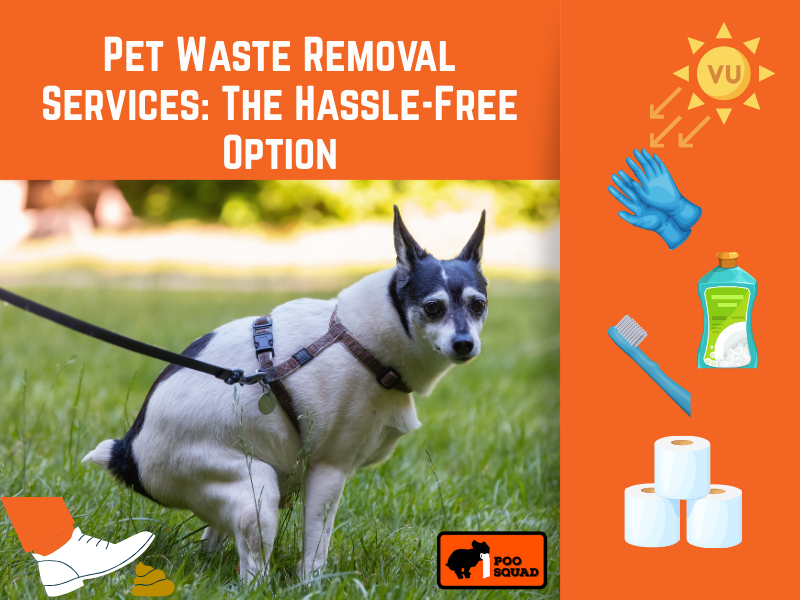
For those who want a clean yard without touching a bag, bin, or shovel, professional dog waste removal services are the ultimate shortcut. It’s not just about convenience, it’s about hygiene, peace of mind, and reclaiming your weekends from a job nobody’s excited to do.
How Services Like This Make a Difference
Not all services are created equal. Some send a random person with a bucket. Others, like the pros who show up in orange uniforms and branded trucks, are more like clockwork, with sanitation protocols that rival a vet’s office.
The real deal includes weekly visits from trained, background-checked techs. Their shoes and tools are cleaned between every yard to avoid passing bacteria from one home to the next. After the job’s done, you get a photo of your locked gate so you know your dog’s safe. That small extra step? Game-changer.
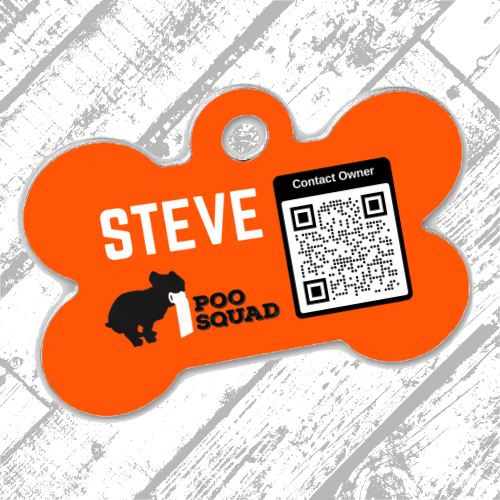
Some even offer pet profiles and QR-coded dog tags. If your pup ever makes a run for it, whoever finds them can scan the tag and pull up contact info instantly.
And let’s not forget the poop itself. You’d be surprised what it can tell you. When techs notice something strange, like diarrhea, discoloration, or even foreign objects, they flag it on a report card so you can catch health issues early. That’s not something you get from a plastic bag and a shovel.
Bonus: no using your hose or trash bins. It’s your space, your tools, your home, and it should stay that way.
Who Benefits Most
The obvious answer is anyone with a dog and a busy schedule. But beyond that, families with young kids, older adults, and those with limited mobility all stand to gain the most.
There’s also the apartment factor. For those living in buildings with no dedicated pet waste stations, it can be tough to manage. That’s where bucket service and event scooping options come in handy, offering flexibility in spaces that aren’t built with dogs in mind.
Eco-Friendly Dog Poop Habits You Can Start Today
Doing right by the environment doesn’t have to be complicated. Small shifts in how you handle daily cleanup can make a big difference, especially when multiplied across millions of dogs doing their business every single day. Here are a few smart habits worth building into your routine.
Use Less Plastic
Those rolls of waste bags add up fast. While convenient, they’re still single-use, and many of the “biodegradable” ones don’t break down properly once they hit the landfill.
There are better ways. Long-handled scooping tools with built-in bins let you skip bags entirely in your yard. Some pet owners go the compostable route, but only if they’re managing a proper compost setup. If you’re not composting, those bags end up in the same place as the regular ones.
Reusable liners and scoop-and-drop containers offer a happy middle ground. They reduce plastic waste and cut back on recurring costs, all without sacrificing cleanliness.
Train for One-Spot Pooping
Yes, it’s possible to train your dog to go to the same corner of the yard every time. Not only does this simplify cleanup, but it keeps the rest of your grass in better shape. Concentrated waste is easier to manage and minimizes tracking, especially if you’re juggling kids or other pets.
All it takes is consistency. Walk them to the same area after meals, reward good behavior, and make that space their go-to bathroom zone. You’ll be amazed how fast it becomes routine.
Respect Public Spaces
There’s no faster way to ruin a dog-friendly trail or park than by leaving behind a landmine. Bagging it and tossing it into the nearest bush doesn’t count as cleanup; it’s just hiding the problem.
If you walk routes with few waste bins, consider carrying a sealable container or installing a small dog station by your front porch. A simple setup with bags and a trash lid makes it easy to handle cleanup without relying on others to do the right thing.
The bottom line? Wherever your dog goes, make sure the mess doesn’t stay behind.
What Not to Do With Dog Poop (Common Mistakes)
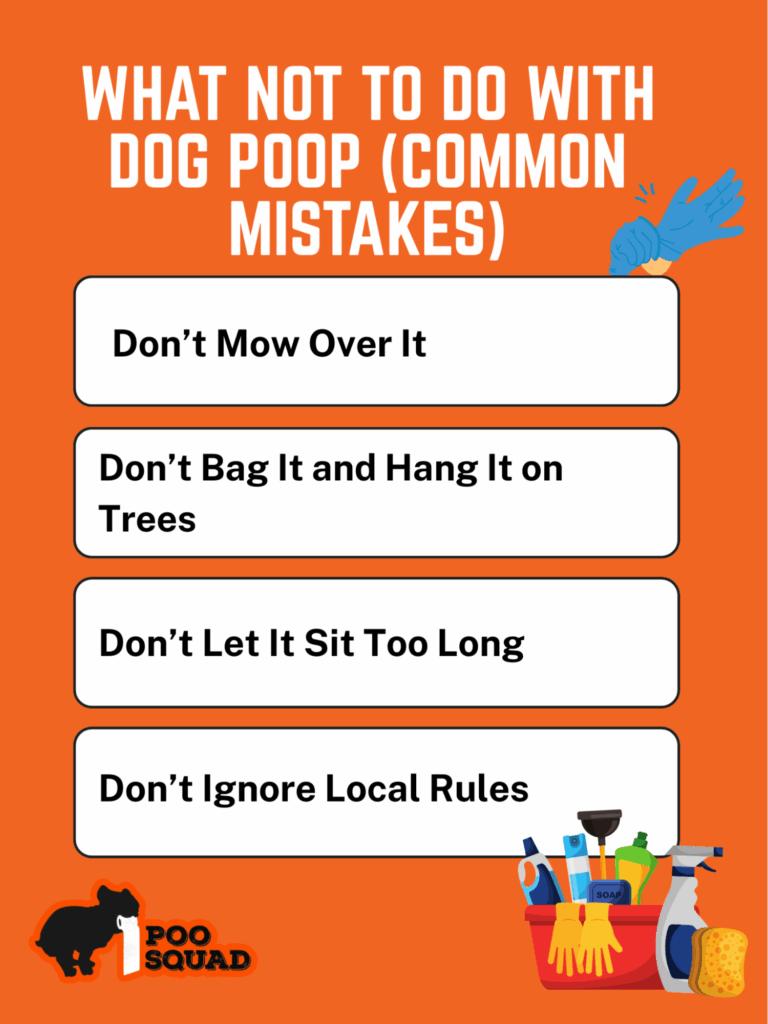
Most people mean well, but dog poop mishandling happens more than you’d think. Some of it’s based on old myths, some on shortcuts that backfire. If you’re aiming for a cleaner yard and a clear conscience, avoid these common missteps.
Don’t Mow Over It
This one comes up way too often: “I just run the lawnmower over it.” Bad idea. That spreads bacteria across the yard, ruins your mower, and sends tiny bits of waste flying, yes, even onto your clothes or pets. It’s not fertilizer. It’s raw waste.
Don’t Bag It and Hang It on Trees
You’ve seen it on trails, poop bags dangling from branches like some kind of weird holiday ornament. It might be meant as a temporary stop, but most never get picked up. That’s just littering with extra steps. If you carried it this far, carry it the rest of the way.
Don’t Let It Sit Too Long
Leave it in the yard or on the balcony, and it quickly turns into a smelly, fly-attracting mess. The longer it stays, the worse it gets, especially in the summer. Cleanup gets harder, and the risk of disease goes up fast. If you’re not handling it within a day or two, it’s time to rethink the system.
Don’t Ignore Local Rules
Some cities have strict disposal laws, especially for public areas. Fines can be steep, and enforcement is getting more serious as urban populations grow.
Bottom line: pick it up, toss it in the right bin, and check your city’s guidelines before experimenting with compost or flushing.
Best Solutions Based on Where You Live
Where you live changes how you manage dog waste. What works on a quarter-acre lot won’t fly in a studio apartment, and vice versa. Here’s how to pick the smartest, cleanest, and least stressful solution for your setup.
Apartment Living
If you’re in an apartment, options can feel limited, but some workarounds don’t involve sneaking poop into someone else’s bin.
Start with an airtight indoor container designed for pet waste. It keeps smells locked down and gives you a place to stash bags until trash day.
In some areas, scheduled pickup services will collect sealed waste right from your doorstep, taking the hassle out of finding a nearby station or hauling it around town. Just be sure to avoid tossing bags into shared bins unless that’s allowed; it’s a quick way to annoy neighbors and property managers alike.
Suburban Homes
With a yard to work with, you’ve got more flexibility. Backyard digesters are a solid investment, simple to install, easy to maintain, and great for reducing smell without adding to the landfill.
Many households turn to professional poop scooping services to keep things automatic and sanitary, especially when time gets tight or the weather turns rough.
For those who don’t mind getting hands-on, composting can be an option. Just remember: only for non-edible gardens, and only with the right balance of heat, airflow, and carbon materials.
Rural Areas
More space often means more dogs and more cleanup. Here, a DIY approach can work well, especially if you’re already accustomed to handling things off-grid.
Carefully managed compost systems work best when placed far from food crops and water sources. Digesters are even easier to implement with extra space and good drainage.
If the smell becomes an issue, pet-safe sanitizers can keep things fresh without harming the soil or nearby animals. Whether you’re running a small kennel or just giving your dogs room to roam, regular cleanup and smart systems go a long way.
Find a Routine That Works and Stick to It
Whether you’re scooping it yourself with a well-worn shovel or letting someone else handle it from start to finish, consistency is what keeps things clean, safe, and tolerable year-round.
Match your approach to your daily routine. Live in a city apartment? Airtight storage and regular drop-offs might be your best bet.
Have a backyard?
Digesters or professional pickups can free up your weekends and keep things sanitary without you lifting a finger.
If you’re looking for the easiest possible route, scheduled cleanup services make the whole thing effortless, from reminder texts and dog poop report cards to sanitation that keeps your space healthy for both people and pets.
Stick to what works, and never underestimate how nice it is to step into the backyard without watching your step.
Author: Chief Scooper
Jamie Coones is the founder of Poo Squad. He started the original location in Manhattan, KS in 2017 and has since licensed the brand to another 20 other owners with locations across the country.
